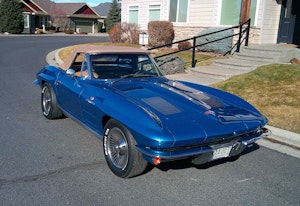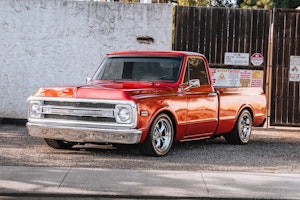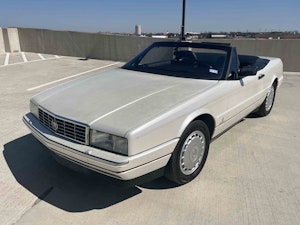Media | Articles
A classic G-wagen is your ticket to analog off-roading in style
Off-roading has become fairly straightforward in many modern cars. Need 4WD Low? Press a button. In the desert and driving on sand? Turn that knob to the icon with a cactus on it. Oh, is that decline a bit steep? Press that button and the truck will just brake for you and descend at your speed of choice. Sit back, catch up on your podcasts, sip a La Croix.
Thankfully, the all-new 2019 Mercedes-Benz G-Class has dodged this automated trend. Despite the fact that virtually every part has been replaced for the venerable off-roader’s first real overhaul since the original Mercedes G-wagen was introduced in 1979. There’s no cactus button or off-roading cruise control. There are center-, front-, and rear-locking differentials, and you need to know when and where to use them. Same goes for low range. It’s comparatively and refreshingly old-school, or at least as much as a modern luxury off-roader with three locking diffs can be.
Ain’t nothin’ but a G thang
20180509125848)
20180509125543)
That original G still strikes a classic chord, though, if you truly want to get in touch with both nature and the chariot that forges you through it. While on the launch of the new G-class in the south of France, we got a chance to drive a variety of classic G-wagens on both paved roads and rough trails. And there’s still something magical about those original G-class SUVs before they were lined in leather, packed with V-8 (or V-12) engines, and became the darlings of Real Housewives everywhere. These were functional, hard-working, honest utility vehicles meant for hard use.
In the early G-wagen, which wasn’t facelifted first until 1990, 4WD High and Low are mechanically engaged by a knob slightly below your hip. The center and rear differential controls spring up from the driveline “hump” like gray plastic mushrooms. The locking front diff was not yet offered. The parking brake is a thick piece of metal with a token rubber grip that operates like you’re muscling open a bomb-bay door. The standard transmission is just that—a standard. The dash may have a tachometer, but it also may not. There were both long- and short-wheelbase options, with the former offered as a four-door and the latter either as a hardtop or cabrio.
Marketplace
Buy and sell classics with confidence
Simple gets the job done
20180509130339)
20180509130112)
The first classic G-wagen we sample is the two-door 1989 300GD Cabriolet finished in baby-blue-with-grey-plaid upholstery. The wheels are small and made of steel. The grille is black plastic. The cloth roof is removed, leaving a charmingly bonkers profile of a trapezoid sitting atop a brick.
It’s immediately endearing. The driver sits high, both off the ground and above the controls. Passengers instinctually grab onto the dash-mounted handle as if on a Disney ride. With the roof and rear quarter panels removed, visibility could only be better if Mercedes had just dispensed with the razor-thin pillars altogether.
The extremely short wheelbase is obvious at every turn and bump. Nevermind the lack of all that new-fangled off-roading frippery, there is literally nothing around today with this vantage point and seat-of-the-pants feel. Not even a Jeep Wrangler.
The hydraulically assisted recirculating ball steering attached to a live front axle is as vague and slow as expected, requiring a nautical amount of turning to navigate a corner. The manual transmission is a pleasant surprise; the clutch is easily modulated; and although the throws are long, they aren’t comically so; and there’s a shocking precision to the gearbox. The shifter itself is oddly short, however, requiring an awkward lean and reach.
20180509125750)
The transmission found in another Cabriolet, a 1982 230 GE Italian fire service vehicle from 1982, had a shifter of an appropriate length (as did those produced prior to extensive modifications made for 1989), but the throws are longer and second gear requires more effort and concentration to get it into place.
Still, it’s better than the optional automatic, which we sample in a 1985 230 GE long-wheelbase, four-door “Wagon” painted safari-spec white. The slushbox sucks nearly every drop of life from the already meager 125-horsepower 2.3-liter gasoline four-cylinder. Throttle response is humorously stunted compared to the adequately alert manual-equipped models, while even modest hills require your foot firmly planted into the floor. If you’ve got a full load of people and gear, yikes. That lion you just startled on safari will catch you.
Even the 102-hp 2.3-liter four-cylinder in the manual-equipped fire service G feels more potent, but it’s the 300 GD and its five-cylinder diesel engine that was the group’s “top” performer. With 88 horsepower, it’s still painfully slow by even modern subcompact car standards (let alone the new AMG G 63 and its 0–60 time of 4.4 seconds), but its stronger torque makes a big difference. Top speed ranges from 130–140 km/h depending on engine and body style, but that would be terrifying given the G’s dynamic repertoire. Not to mention that the fire service Cabriolet began to be deafening with the roof up at around 45 km/h.
Rutted trails and steep inclines in a classic G
20180509130039)
20180509130140)
Despite its lack of guts, it was the 230 GE Wagon we took off-road. Though mechanical sympathy for the meticulously maintained 33-year-old SUV kept us from serious rock-crawling, the old mountain goat didn’t bat an eye at chugging up the same rock-strewn inclines and rutted trails we had tackled in the 2019 G-Class hours earlier. There was no need for a button labeled “Rock”—the small tires weren’t anything special, and heck, we operated in rear-wheel drive most of the time.
True, there’s less of a safety net for novices with a classic G-Wagen than in the supercomputer-equipped modern version. If it’s your first rodeo, attending an off-roading driving school in advance is highly recommended.
Servicing them and even finding one to buy can be difficult since the G wasn’t officially imported to the United States by Mercedes-Benz until 2001 (and even then, only high-lux four-door versions made the trip), but a steady stream of imports and helpful owners clubs makes the prospect less daunting.
If you’re looking for something profoundly different, something refreshingly analog, and most importantly, something positively charming and cool, hitting the trail in a classic Mercedes-Benz G-wagen is just as endearing as you’d hope.
20180509125931)








20180509130704)
20180509130454)
20180509130516)
20180509130542)
20180509130726)
20180509130835)
20180509131155)
20180509125619)
20180509125822)
20180509130022)
20180509130210)
20180509130245)

